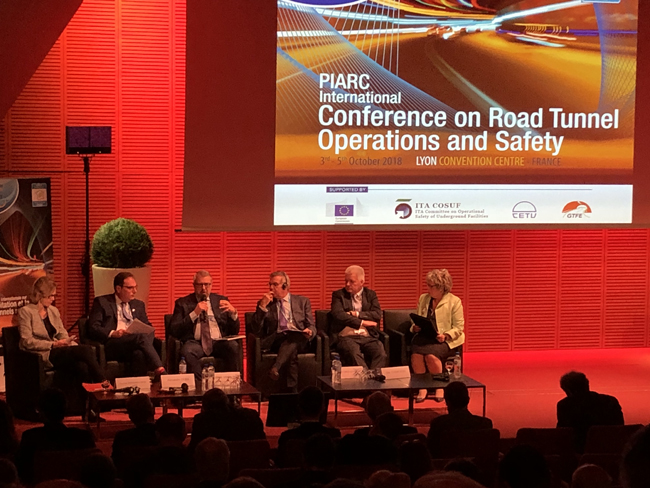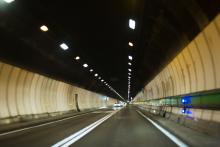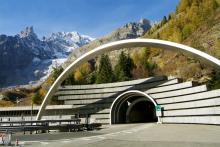
More than ever, tunnel management must done in a holistic fashion, said Andre Broto, president of
One of the first speakers, Sandrine Bernabei Chinzi, head of transport infrastructure at France’s Ministry of Ecology, said all the upgrades in the world will never eliminate risk in road tunnels. Complacency remains the enemy of all tunnel operators globally, she told the 300 delegates to the conference held in the French city of Lyon in October.
Since the tragic fire in Mont Blanc Tunnel in 1999, France has spent more than €2 billion upgrading its road tunnels. The 11km Mont Blanc Tunnel links Chamonix in France with Courmayeur Italy via European route E25. Thirty-nine people died when a Belgian transport truck carrying flour and margarine caught fire.
Around 90% of tunnel upgrade work in France has been done and there has been an marked drop in tunnel events because of it. “But fires will happen,” she warned. France has fitted many of the latest smoke detectors, fan units and people-evacuation systems. These must, of course, be maintained as part of strategic tunnel maintenance. She also urged operators to carry out many more exercises to understand human behaviour during emergencies.
But there many challenges are on the horizon, said Chinzi. Not the least of them is the variety of fuels in vehicles, such as high-powered battery systems, hybrid power systems and hydrogen. How will these react during fires? Under what conditions will they start fires? These questions must be explored.
Operators are facing increasing energy efficiency issues, said Alexandre Debs, project manager at the ministry of transport for the Canadian province of Quebec. In colder climates, such as Canada, it is important to ensure new tunnel management and safety systems remain heated to ensure adequate performance. But energy costs must still be kept down, he said.
Quebec is trying to use less salt during winter to keep roads clear of ice. Heating certain slabs and parts of the road is one option. But this, again, requires energy – all in the age of making infrastructure energy-neutral, he noted.
Around 22% of energy costs for the tunnel section of Montreal’s Louis-Hippolyte Lafontaine Bridge–Tunnel that runs over and beneath the Saint Lawrence River goes towards heating mechanical systems to ensure perfect performance during cold weather. A call for proposals will likely go out early next year for upgrades to the tunnel that was opened in 1967, he said.
Stand and deliver
Matthieu Taboureau, director of operations for the Lyon security and safety contract held by GSA: Taboureau demonstrates the IFEX 3001 Impulse firefighting gun specially motorcycle-mounted for use by quick response teams. As part of the contract, emergency services must respond to an incident in a Lyon tunnel within four minutes of notification. The gas-powered IFEX system, made of rustproof steel, shoots a litre of water or foam at close to 400kph, aimed at the base of a fire.Similar to motorway operators, tunnel operators face challenges and risks from automated vehicles, said Henric Modig, leader of PIARC’s working group on human factors and intelligent traffic systems. Automated vehicles have a great ability to collect data about their surroundings. “It’s time to see automated vehicles as not just something passing through a tunnel but part of the tunnel system itself,” said Modig, a specialist in tunnel safety at Trafikverket, Sweden’s Transport Administration.
Fuel for thought
For example, in the event of an accident, an automated vehicle could relay information to the rescue and fire services about the vehicle if it is in distress or on danger. How many occupants are inside? Are any of them disabled or small children? What type of fuel is on board and how much? This is extremely important information for emergency services teams when they first arrive on the scene. It could be relayed directly tunnel control centres, he suggested.
Unfortunately, overall there are more questions than answers about the behaviour of alternative fuels in vehicles during a serious accident, said Gary Clark, who sits on PIARC’s vehicle emissions working group. For example, what types of vehicle battery packs are subject in certain conditions to thermal runaway, asked Clark who is chief engineer for the tunnel ventilation and fire life safety team at Atkins, a UK infrastructure company. How much toxicity will occur in the atmosphere?
Another concern is extinguishing these fires, or at least thinking you have. The burning may be extinguished but the fuel might remain unstable for some hours or even days, making it liable to re-ignite without warning. For this reason, explained Clark, these vehicles may need to be taken into isolation for up to 14 days before the fire is declared truly out.
Given these uncertainties, there might be an issue over even letting automated vehicles and vehicles whether automated or not, with certain types or standards of fuel use a tunnel, said one delete in the audience during a panel discussion.
Would tunnel owners and, or, operators be able to ban vehicles that they deem an unusual threat to safety? Most likely, should there be a need for a ban, it would be done in conjunction with tunnel operators, vehicle manufactures and politicians, said Modig.
Croix-Rousse
How do you expand a tunnel when it has reached its traffic limit? Build another tunnel parallel to it. That, at least, is what Lyon did and opened the 1.7km Croix-Rousse dual-tunnel system in 2013. The smaller new €283 million tunnel has become a symbol of Lyon’s intention to reinvent itself as one of France’s most innovative mobility centres, said Mathieu Hermen, ahead of operations at La Metropole de Lyon.
Construction of the original two-lane tunnel under one of the city’s most densely populated arrondissements started in 1939. Work was halted by the Second World War when the site was used as an air-raid shelter. It was finally opened in 1952. The original tunnel has a speed limit of 50kph and nearly 50,000 vehicles use it daily.
A concrete barrier was installed in 1998 to physically separate the two lanes, both of which have a useable width of almost 6m. But physical deterioration by then was starting to be a concern, as well as a lack of escape tunnels meant something had to be done.
Much consultation ensued to consider options such as double-decking the original tunnel and widening it. But the chosen option was to make a parallel tunnel and use it for more eco-friendly modes of mobility.
The single vehicle lane is for public transportation – buses – and there is a separate two-way cycle path as well as a wide separate pedestrian path. Thanks to 11 cross-galleries the latest 10m-wide tunnel acts as the escape tunnel for the original vehicle tunnel, explained Hermen. Around 2,300 cyclists and 2,000 pedestrians use the new tunnel each day.
The busway – a one-way direction - can be later adapted for use by a tramway should the city decide to go down what route. Only one bus at a time is allowed through the tunnel in case of a breakdown that could snarl up other buses behind the stricken vehicle.
A barrier, almost a 1m high, separates the busway from the cycle lane. But there are many sections of the barrier that will slide open in the case of an emergency and people need to escape the tunnel. The escape cross-galleries are sealed by heavy doors that are motorised for ease of opening from inside. There are also digital temperature readouts inside the galleries so occupants know, in the case of a fire, what temperature it is right behind the door.
A main control centre for all motorways and the tunnels in Lyon lies some way from the tunnel, but there is a small operations control centre at one end of the new Croix-Rousse for monitoring an emergency situation on-site.
During a technical tour of the Croix-Rousse “eco-tunnel”, delegates experienced the three-dimensional video show that covers much of the infrastructure’s walls. The artistry and imagination has turned a city commuter’s daily experience into a must-visit for many tourists to Lyon.









